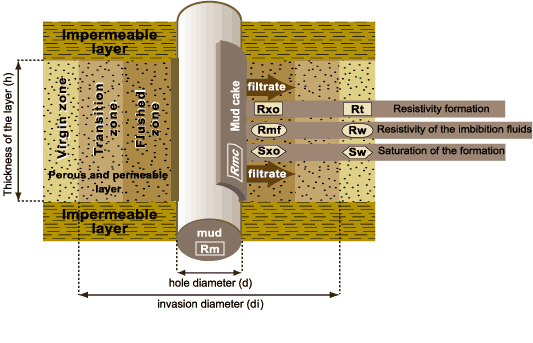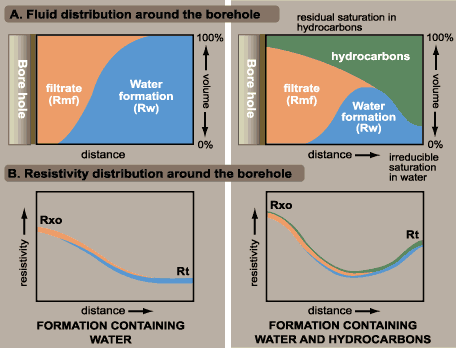Generally, the presence of the drilling fluid generates disturbances. In the most general case, the drilled formations contain fluids (water and hydrocarbons) which must be maintained in place to avoid their arrival at the surface. To accomplish this, the drilling mud exerts a hydrostatic pressure higher than the pressure of the formations and fluids which they contain.
Under these conditions, formation is invaded by mud filtrate. The solid particles accumulate on the walls of the hole, forming what is known as mud cake. The thickness of the mud cake varies in general between 1/8 and 1 " (3 mm to 2.54 cm). This mud cake has a low permeability depending on its constiturents, and these determine the degree of filtrate invasion and eventual final mud cake thickness. The filtrate that invades the pore space of the rocks disturbs the original distribution of the fluids, and its physical characteristics contribute to modify the total formation response to borehole logging measurements.

![]() Schematic representation of invasion
Schematic representation of invasion
- The mud, with a resistivity Rm fills the borehole
- Fitration has left a deposit of mud ( mud-cake) with a resistivity Rmc
- The filtrate, or aqueous phase of resistivity Rmf, has forced the formation water back for some distance creating a flushed zone.The resistivity of this zone is Rxo
- On moving away from the walls of the borehole, the volume percentage of filtrate decreases until we reach the virgin zone where there is complete saturation of the pores with the formation water Rw. The formation then has a resistivity Rt.
- The zone ranging between the borehole and the virgin zone is the invaded zone with a resistivity Ri and a diameter di .
The drilling fluids influence in a different way the formation containing water or hydrocarbons.

![]() Invasion (with and without hydrocarbons)
Invasion (with and without hydrocarbons)
A. Distribution of the fluids around the borehole
B. Distribution of the resistivities around the borehole